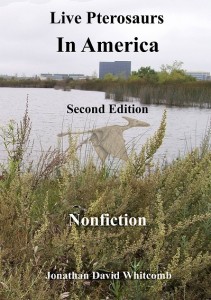William Gibbon’s nonfiction cryptozoology book Missionaries and Monsters has a chapter on “Winged Wonders” (with reference to the Biblical “fiery flying serpent”). Before getting into details about living pterosaurs, here is part of the publisher’s information:
Bill [Gibbons] collects reports of mystery animals from missionaries and others, with chapters on lake monsters, sea serpents, unknown apes, and the possibility of living dinosaurs. Some of these cryptids look like species from the fossil record, while others (like the “Nepal Dragon” sighted in 1980) don’t resemble known species at all.
I recommend this book for its many eyewitness accounts of cryptids from around the world, some of which suggest living dinosaurs and pterosaurs. I’d rate the book “4.5 stars out of 5.0” and hope to some day research some of the reports in the “Winged Wonders” chapter (those I have not yet researched), and I encourage other cryptozoologists to investigate reports of living pterosaurs in the southwest Pacific.
That said, certain details about the flying creatures called “ropen” and “Duah” I do not recommend be repeated without reference to more recent living-pterosaur investigations in Papua New Guinea, from expeditions more recent than those on which Gibbons has relied.
Before getting into details, from pages 76-78, on which I disagree, let it be known that I agree that different varieties of modern pterosaurs live in Papua New Guinea. And varieties of basic types of classified organisms (the non-cryptids) commonly include different sizes: elephant seals out-weigh harbor seals; anacondas out-length gopher snakes; Goliath beetles out-bug boll weevils. Strange as it sounds to Westerners ignorant of living-pterosaur investigations in Papua New Guinea, I believe (as do at least some of my associates) that different species of pterosaurs, of different sizes, fly over jungles of the southwest Pacific, including more than one species in Papua New Guinea.
Hundreds of isolated villages and hundreds of village languages are scattered across Papua New Guinea. Gibbons seems to have relied on reports from Carl Baugh, perhaps without adequately considering the reports from more recent explorers (Paul Nation, David Woetzel, Garth Guessman, and me). Regardless, general references to words in native languages of Papua New Guinea need to be taken in context with this diversity of languages, and “ropen” and “duwas” (regarding pterosaur-like flying creatures) come from different languages.
“Duah,” to the best of my knowledge, is not a flying-creature word in any village-language in Papua New Guinea (although in Tok Pisin it means “door”). “Duah” probably comes from some American who assumed that “duwas” was a plural for the giant flying creature known in various parts of the country. So when Gibbons refers to the “Duah” and the ropen, it seems that the comparison should actually be between the duwas and the ropen.
But another problem flies up here: The word “ropen,” when used for a featherless flying creature that is not a bat, is the word used in various villages on Umboi Island, where there is probably no other word for any similar creature; likewise, if a researcher were to interview natives in villages where “duwas” refers to a featherless flying creature larger than fuit bats, those natives probably would have no other word for any similar creature. In other words, the difference between a duwas and a ropen is probably only the difference between the spellings of “duwas” and “ropen,” and those different words tell us nothing about size-differences of flying cryptids in Papua New Guinea.
So rejoice in the good news of some apparent diversity in pterosaurs in the southwest Pacific. The bad news? We are still mostly ignorant of many biological details, notwithstanding random references to flying creatures (of various reported-sizes) connected to various words in various languages. How much we have to learn about these amazing non-extinct flying creatures of Papua New Guinea!
_______________________________________________________________________
Advertisement
 Live Pterosaurs in America, by Jonathan David Whitcomb, is a nonfiction book in the true genre of cryptozoology. Read the astonishing accounts in the words of the eyewitnesses themselves. Sightings are examined in detail, and they are from many states, including California, Texas, Arkansas, Florida, Georgia, South Carolina, Ohio, Michigan, Kansas, and other states. This book has sold better than any other cryptozoology book about living pterosaurs, on Amazon.com from late 2009 through mid-2010.
Live Pterosaurs in America, by Jonathan David Whitcomb, is a nonfiction book in the true genre of cryptozoology. Read the astonishing accounts in the words of the eyewitnesses themselves. Sightings are examined in detail, and they are from many states, including California, Texas, Arkansas, Florida, Georgia, South Carolina, Ohio, Michigan, Kansas, and other states. This book has sold better than any other cryptozoology book about living pterosaurs, on Amazon.com from late 2009 through mid-2010.
Bored with life, or know someone who is? Thrill to these encounters with flying creatures that some outdated American cultural traditions teaches us are long extinct. They are not extinct but very much alive.
For some teenagers and pre-teens, this book on living pterosaurs is a sure cure for boredom, with accounts of interviews conducted by both old and young American cryptozoologists, including one of the age of only twelve years.


